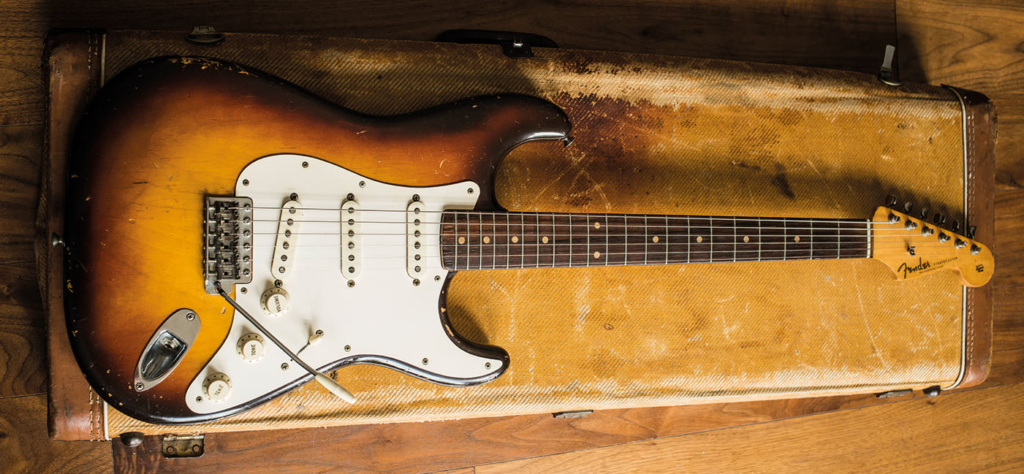A Quick History of the Fender Stratocaster
The Fender Stratocaster is more than just a guitar; it is an iconic symbol of modern music, transcending genres and generations. Since its inception in the early 1950s, the Stratocaster has played a pivotal role in shaping the sound of rock, blues, pop, and even jazz. This article delves into the rich history of the Fender Stratocaster, exploring its origins, design evolution, and cultural impact. Whether you’re taking Los Angeles guitar lessons or simply a fan of guitar history, understanding the story of the Stratocaster provides valuable insight into the instrument that revolutionized music.
The Birth of the Stratocaster
The Fender Stratocaster was introduced in 1954 by Leo Fender, George Fullerton, and Freddie Tavares. Leo Fender, a pioneer in guitar manufacturing, had already made waves with the Fender Telecaster and the Precision Bass. The Stratocaster was designed to build on these successes, offering improved playability and a broader range of tones.
Key features of the original Stratocaster included a contoured body for comfort, a double-cutaway design for easier access to higher frets, and three single-coil pickups for a variety of tonal options. The tremolo bridge, also known as the “synchronized tremolo,” allowed players to bend the pitch of notes, adding a new dimension to their playing. These innovations made the Stratocaster a versatile and highly playable instrument.
Early Adoption and Impact
In its early years, the Stratocaster was quickly adopted by pioneering musicians who appreciated its unique sound and playability. One of the first prominent artists to embrace the Stratocaster was Buddy Holly, whose use of the guitar in the late 1950s helped bring it into the mainstream. Holly’s performances on television and his recordings showcased the Stratocaster’s clean, bright sound, influencing countless aspiring guitarists.
The Stratocaster gained further prominence in the 1960s, as it became the instrument of choice for legendary guitarists like Jimi Hendrix, Eric Clapton, and Jeff Beck. Hendrix, in particular, pushed the boundaries of what the guitar could do, using feedback, distortion, and his extraordinary playing technique to create sounds that had never been heard before. His iconic performances at Woodstock and other major events cemented the Stratocaster’s status as a symbol of rock music.
Evolution of the Stratocaster
Over the decades, the Fender Stratocaster has undergone numerous changes and refinements, reflecting advancements in technology and shifts in musical tastes. Despite these changes, the core design and spirit of the Stratocaster have remained remarkably consistent.
1950s and 1960s
The earliest Stratocasters featured ash bodies, maple necks, and a sunburst finish. In the late 1950s, Fender introduced alder as a body material, which became the standard wood for most Stratocasters. Rosewood fingerboards were added as an option in 1959, providing a different feel and tone compared to the original all-maple necks.
1970s
The 1970s saw Fender experimenting with various design modifications, including changes to the headstock size, neck profile, and pickup configurations. Some of these changes were met with mixed reactions, but they demonstrated Fender’s willingness to innovate and respond to player feedback.
1980s and 1990s
In the 1980s, Fender faced increasing competition from Japanese manufacturers, leading to the creation of the Fender Japan line. These instruments were known for their high quality and affordability. The American Standard Stratocaster, introduced in 1987, featured modern updates such as a flatter fingerboard radius and improved electronics, appealing to contemporary players.
2000s and Beyond
In the 21st century, Fender has continued to refine the Stratocaster, offering a wide range of models to suit different playing styles and preferences. The Custom Shop, established in 1987, produces high-end, custom-built Stratocasters for discerning musicians. Meanwhile, the Player Series and other lines provide affordable, high-quality options for beginners and intermediate players. Many students taking Los Angeles guitar lessons often start with these accessible models, allowing them to experience the Stratocaster’s legendary playability and tone.
The Stratocaster in Popular Culture
The Fender Stratocaster has not only influenced music but also made a significant impact on popular culture. Its distinctive shape and sound are instantly recognizable, making it a favorite among artists across various genres. From the early days of rock ‘n’ roll to modern pop and beyond, the Stratocaster has been featured in countless recordings and performances.
Guitarists like Stevie Ray Vaughan, Yngwie Malmsteen, and John Mayer have further expanded the Stratocaster’s legacy, each bringing their unique style and tone to the instrument. Their work has inspired new generations of players, many of whom take Los Angeles guitar lessons to learn how to emulate their heroes.
Conclusion
The Fender Stratocaster’s journey from its revolutionary beginnings to its status as a cultural icon is a testament to its enduring appeal and versatility. Whether you are an aspiring guitarist taking Los Angeles guitar lessons or a seasoned player, the Stratocaster offers a unique blend of history, innovation, and unmatched playability. Its influence on music is undeniable, and its legacy continues to grow with each new player who picks up this legendary instrument. As you explore the world of guitar playing, the Fender Stratocaster remains a symbol of creativity, expression, and musical excellence. If you’re interested, book a lessons with Los Feliz Guitar Lessons to explore this legacy!

